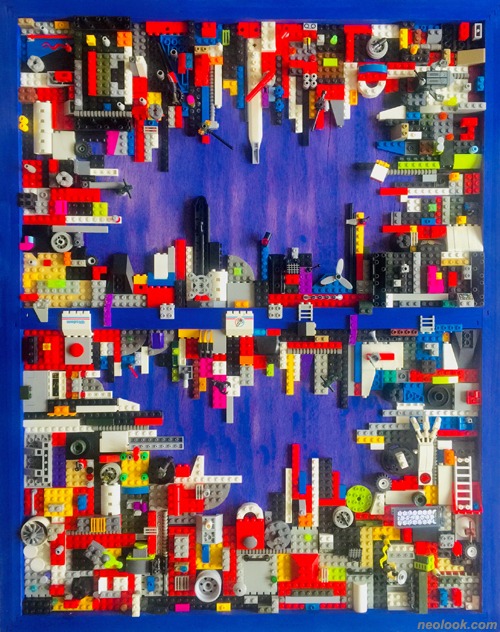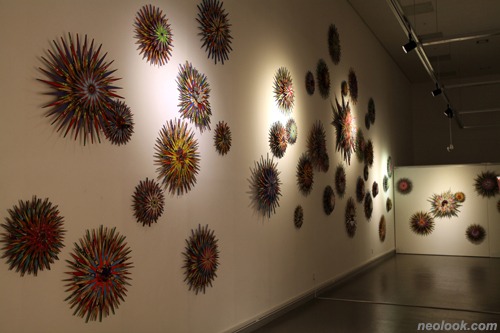
| Period| | 2020.02.11 - 2020.02.29 |
|---|---|
| Operating hours| | 10:00-17:00 |
| Space| | Sungok Memorial Hall |
| Address| | 11, Yeongsan-ro, Mokpo-si, Jeollanam-do, Korea |
| Closed| | Monday |
| Price| | Free |
| Phone| | 061-244-2527 |
| Web site| | 홈페이지 바로가기 |
| Artist| |
조창환
|
정보수정요청



|
|
Exhibition Information




Specifications, limited freedom, and deserterization-Modeling work of Cho Chang-Hwan At one time mankind worked hard to dig up the inner parts of the world and decipher the eggs of things and build up the golden tower of civilization. Civilization grew more and more divided. The act of seeing is so fragmented. For some time art was reduced to a cramped area of absoluteism or minimalism and gradually retreated to a dead end. Since then it has been freed from discipline and re-emerged as a miscellaneous story, going through the revival path of neo-expressionism, post-modernism, or deconstructionism. Yet again, art released from the hinges of normality has gained the key to the universal channels allowed by digital standards, instead of losing its previous analog freedoms. Digital filtered everything in binary and unified it into a common code where the contact surfaces matched each other. It has brought freedom of ubiquitous communication to the world based on standardized compatibility. This series of processes summarizes the existing thing as breaking into small pieces, standardizing it into minimal pieces, and then weaving it back into new objects. Cho Chang-Hwan's work is one of the pillars of this aesthetic story line. He goes beyond the weak link of 'being an artist' and seeks more original act of creativity. It's like taking over the structure of the world and putting it back together. In other words, the principle of building the world with a few simple standards is to get him to carry out his creative work. Instead of being driven by the binding process of the artist being central and deciding everything, let the elements that make up the creative act work on their own by a few limited. Usually when a writer loses his freedom by trying to control the processes and consequences of all his work, on the contrary, he gains more creative freedom by releasing the reins of these restrictions. The main body of a puzzle piece or Lego block is that each module has a retard with the same size of bumps. By doing so, they can fit in with any pair of partners. The key to that is standardized compatibility. It gives fragmented modules the flexibility to weave any shape. Cho Chang-Hwan applies the characteristics of these modules to break down existing features and create new ones again using relatively uniform patterned debris from them. So what is the difference between the existing object and what is newly created? We have a preconceived notion that art should contain the individuality of the writer. Individuality at this time is self-confidence, which is rooted in self-interest and has a firm right to self-determination. But our egos are always in imperfect obscurity. Gilles Deleuze talks about the way of life 'becoming an artist' as a journey from a kind of desertion to a re-zeroing. An artist must first get away from himself and go to a new unknown land. The psychoanalytical concept of Jacques Lacan's mirror stage is also about finding ourselves as another batter, but we always meet typewriters in the world. It is only by meeting a batter that the ego becomes deserter from its own cramped ground. Early on, the idea of self served a selfish world with reason at the center. It has led human civilization to a confrontation with dangerous hitters by enlarging the arrogance and prejudice of self in the world. This has resulted in numerous extreme confrontations and a worldwide crisis of catastrophic competition and constant conflict. Cho Chang-Hwan's modeling work, on the other hand, is setting foot on the cause and visual freedom that neutralizes the confrontation between the self and the batter. True freedom reaches a vast sea of reconciliation, free from self-absorbing and giving oneself up to one another. If everything fits the set standards, it will be free to fit in with anything different. It is free from constraint and produces a freer meeting. The idea of being free by restricting so-called freedom is seemingly contradictory, but this oxymoron is like a Unicode that runs through an era of technological revolution where everything is increasingly networked based on artificial intelligence. We are already in the middle of an era of all ubiquitous communication. The standardization process in the analogue era has driven the development of the machinery industry. Also, in the digital age, the ecosystem of all things was transformed into an infinite combination of two modules, which was standardized to zero and one. It has brought about the age of the Internet of Things, where everything interacts with anything else. Cho Chang-hwan's work is in line with this period trend. Package boxes made according to several different sizes can be easily packed with any object. In his past work, Cho first cut out paper boxes used for such packaging and created a kind of fragmented module, then put them together and stacked them together to combine some unknown shape that makes it possible. In such a task, the form of conception is only in the author's head, and what is specific is determined in a way that modules naturally allow in the process of attaching and stacking box pieces. Here, the author’s creation depends in large part on the nature of the module in the cut-out package box, the chance that colors or shapes trigger. The line of works featuring Android, such as human head, reflects the accidental and inevitable creativity that arises as the author’s vague imaginative sketches become reality in the conceptual Android is based on the standard form of human figures. In humans, omitting individuality leaves a common shape and function. In principle, human personalities can also be all tangible through genome analysis. Reordering such dissolved elements with some kind of algorithm may become an Android circuit that will create a new civilization. The result would create a fundamental problem that would have to redefine human concepts. But it is something that can basically be derived from human civilization in succession. Because it reflects the attributes of the genome, a common module that derives itself. The core of the artist’s work lies in the macro-level coincidental results: the micro-levels that are inevitably created by a package box that is modular in its basic form or structure, and the overall shape that it binds. Of course, the writer vaguely envisions a painting, but it is derived as an unknown form through a process that is realised according to the conditions of the package box module. Modules made from package boxes form a part of a whole with their original colors and designs divided. The original use and specifications of the original package box are destroyed, and another element of the original package, such as flatness and color, contextually cut design and typography, creates a whole new order of form. The characteristics of a module are the uniformity that equality creates. Basically, it has the same structure, which reflects the characteristics of identity when it is achieved in its entirety, but the overall form is implemented as something different from individual modules. It acts as an individual unit that is assembled like a piece of a puzzle or a Lego block to form another whole. In the above work, if it does not follow the specific shape of the head and produces an unstructured geometric shape, it results in a chain fractal structure that results from the same structure that the module has. Fractals appear in the form of attributes or shapes that the part has in the whole structure. A module combines with another module, which is basically the same structure, to make a part of the whole, but the pattern of the original color or slightly different changes makes the difference more as it swells, eventually creating a whole different whole. Here, the writer would have had to keep up with the process in which the module was almost self-made by suppressing the intervention of his own intentions or modelling to a minimum. This is a process of deserting beyond the territory of a highly playful and fixed self. The overall form expressed here is driven by a meeting of non-reversive coincidences and inevitable, which seems to be similar in the same form but cannot be repeated again. The overall pattern in this process is the result of creative generation by chance, which results in module variability. Thus, this creates a new storyline depending on how the story with elements such as letters and colors of the design that the existing package box has appears to be divided. The existing story breaks down and is returned to the accidental storage element, which in turn creates a new story by easily combining with others by retaining the characteristics of the module itself. This is arranged in a way that by-products of industrial environments are transformed into new structures on their own with minimal intervention by the author. It features variability that can be infinitely transformed according to existing fragmented individual stories rather than the will of the author. It is somewhat similar to each other, but the results of each task appear in a different light each time. In other words, it is not a completely different story, but it is embodied like any other expression of the same story. This is the same difference that equality repeats with different strengths and rhythms. As Jacques Monod said in 『The Coincidence and the Necessity,』 what happens in the natural world is bound to be created by coincidence, but that doesn’t mean that any purpose, or unity, is already set in the world. The core of this play, therefore, lies in the natural freedom of the artist's will to minimize, and in which natural or extraterrestrial order or rules create the formulation. The significance of artist Cho Chang-Hwan's work seems to be limited by following several set standards, but it can be found in the infinitely variable order created by standard freedoms that open the possibility of meeting each other freely. It is only possible when a artist does not reduce the formative freedom that reveals himself in a way that insists on some form, thereby giving birth to infinite variation. In the 「Garden No.9」 series, which he announced in May 2017 in the name of artist Kim Sung-ho and the group 'Puzzle H,' circumstances clearly indicate that he tried to minimize the involvement of the artist’s individual by dividing a portion of his work with another artist, where the virtue of such work has been fully corroborated.
